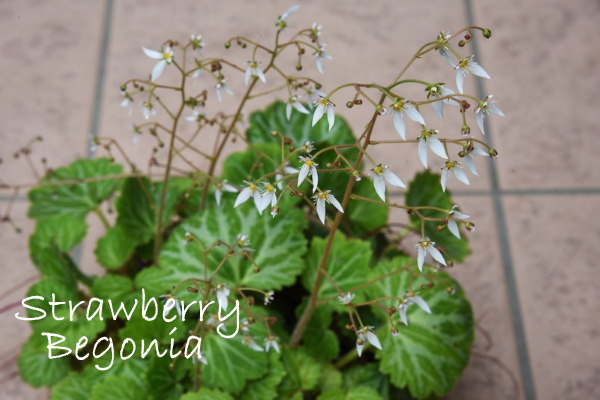Strawberry Begonia Plant Care
Strawberry Begonia grows in a mound of rounded, scalloped leaves with decorative silvery veins. The leaves are hairy with burgundy-red undersides.
Its most charming feature, though, are the long runners with plantlets dangling from the plant. Display it in a hanging basket to show them off.
 Branched flower spikes decorate this plant in summer. Photo © Yorozu Kitamura
Branched flower spikes decorate this plant in summer. Photo © Yorozu KitamuraGet to Know Strawberry Begonia
In its native habitats of China and Japan, Saxifraga stolonifera grows as a groundcover, spreading quickly by its runners that readily take root.
This plant likes cool temperatures, but is frost-tender. Keep it cool and moist, and it makes an easy-care house plant.
How big does strawberry begonia get? It may grow up to 8 in (20 cm) tall. Its runners trail to 12 in (30 cm) or more.
Sprays of tiny, white star-shaped flowers on tall stems may appear in summer. You can encourage more flowers by allowing a cool, dry rest for a few weeks in winter.
A few varieties are available. 'Tricolor' has small, green leaves with creamy yellow margins, flushed with pink. Rare variegated varieties exist with dark-green leaves edged in creamy white -- and in bright light, become edged in pink.
Is strawberry begonia toxic to cats and dogs? No, this beautiful houseplant is safe to grow in a home with pets. Although, you don't want them munching on it. Those dangling leaflets may be attractive to playful pets -- another reason to hang it up.
Growing Strawberry Begonia Year-Round
Repot in spring every couple years or when the roots fill the pot. Put it in a hanging pot to show off its trailing plantlets. Use a pot with drainage holes to prevent soggy soil.
Winter Care. Give this evergreen plant a dry, cool rest in winter. Keep it in a cool (50-55°F/10-13°C) place, and water sparingly, but don't allow the soil to dry out. It'll suffer in the dry air caused by central heating. Use a humidity tray or room humidifier, if necessary to raise the moisture in the air around it. Watch for an invasion of spider mites that are attracted to dry conditions.
This plant is neither a strawberry nor a begonia. Its common name comes from those colorful, decorative leaves like a begonia, and because it spreads by runners like a strawberry plant.
Strawberry Begonia is in the Saxifragaceae family, along with Piggyback Plant.
What these two have in common besides attractive foliage is a trailing habit and their ability to produce plantlets that are easily propagated.
How to Propagate Strawberry Begonia
Propagating strawberry begonia is easy to do from runners. Here's how to do it...
Place small pots around the parent plant. Leave the runners attached and, using a bent paper clip, hold plantlets down into moist potting mix.
The plantlets will quickly form roots. After 3 weeks, you can cut the runners to detach them from the parent plant.
At-a-Glance Strawberry Begonia Care
Light: Bright light year-round. Some direct morning sun is fine, but shade from strong sun, which can cause leaves to fade.
Water: Water thoroughly and allow the top inch (2.5 cm) of soil to dry between waterings. Water less in winter, when growth is slower. Overwatering can lead to root rot or crown rot and may cause fungus.
Humidity: 40-50% relative humidity. Use a pebble tray or a cool-mist humidifier if air is dry. Don't mist strawberry begonia because the fine drops of water are trapped by the hairy leaves and may lead to fungus.
Temperature: Cool to average room temperatures 50-75°F/10-24°C
Soil: Any good-quality, all-purpose potting mix
Fertilizer: Feed monthly in spring and summer with a balanced water-soluble fertilizer.
Strawberry Begonia Problems and How to Fix them
Brown, crispy leaves?
Dry-looking foliage can be caused by a few things:
- Direct sun can cause leaves to look faded or brown. Keep Saxifraga stolonifera out of strong summer sun.
- Crispy, shriveled leaves are often a sign that the air is too dry. Use a pebble tray or a room humidifier to raise the humidity around the plant. Don't mist this plant because the tiny hairs trap water and may cause the leaves to rot.
- Dry soil could also cause dry leaves. Aim to keep the soil lightly moist.
Wilted or Collapsed Plant
Strawberry begonia will wilt if the potting medium dries out. Water throroughly, and your plant should perk up again.
But... what if you water regularly and your houseplant is drooping?
You overwatered -- a lot. Soggy potting medium can cause the plant to collapse. And if the leaves turn yellow, the plant may be suffering from root rot. Allow the potting mix to dry out before watering again. It's always best to use a pot with drainage holes to prevent soggy soil.
Troubleshoot Houseplant Pests
Watch for aphids that are attracted to new growth, which strawberry begonia has in abundance. These tiny, wedge-shaped insects can usually be washed off with warm water. If you have some stubborn bugs, spray your plant with insecticidal soap.
Pale and speckled leaves, covered with fine webbing are caused by spider mites. Isolate an infested plant to prevent these dreaded pests from moving on to your other indoor plants. Treat your plant right away. Has your houseplant suffered serious damage? Cut off badly infested leaves and dispose of them.

